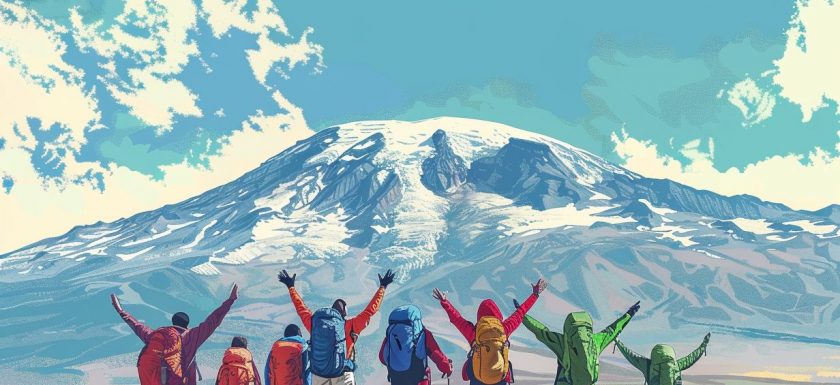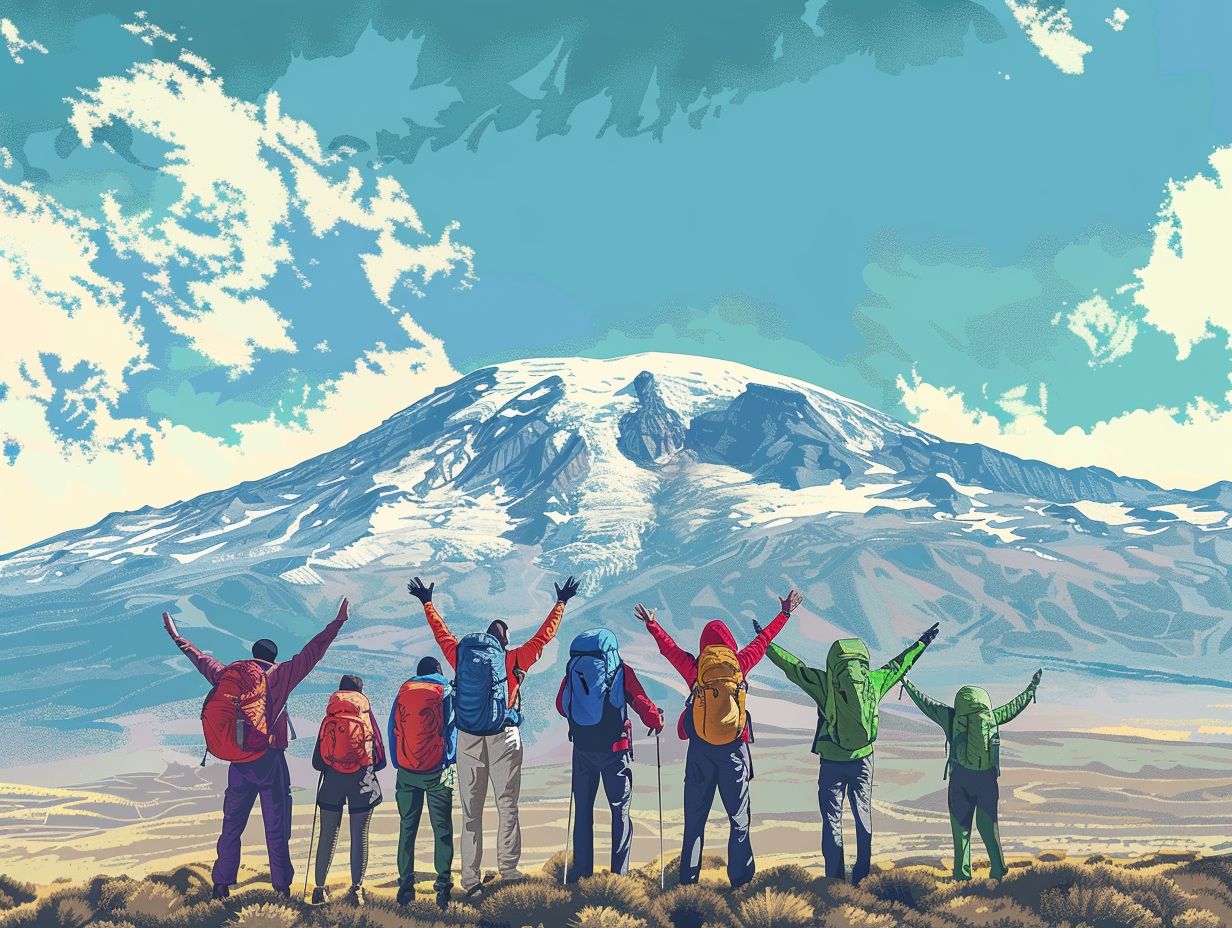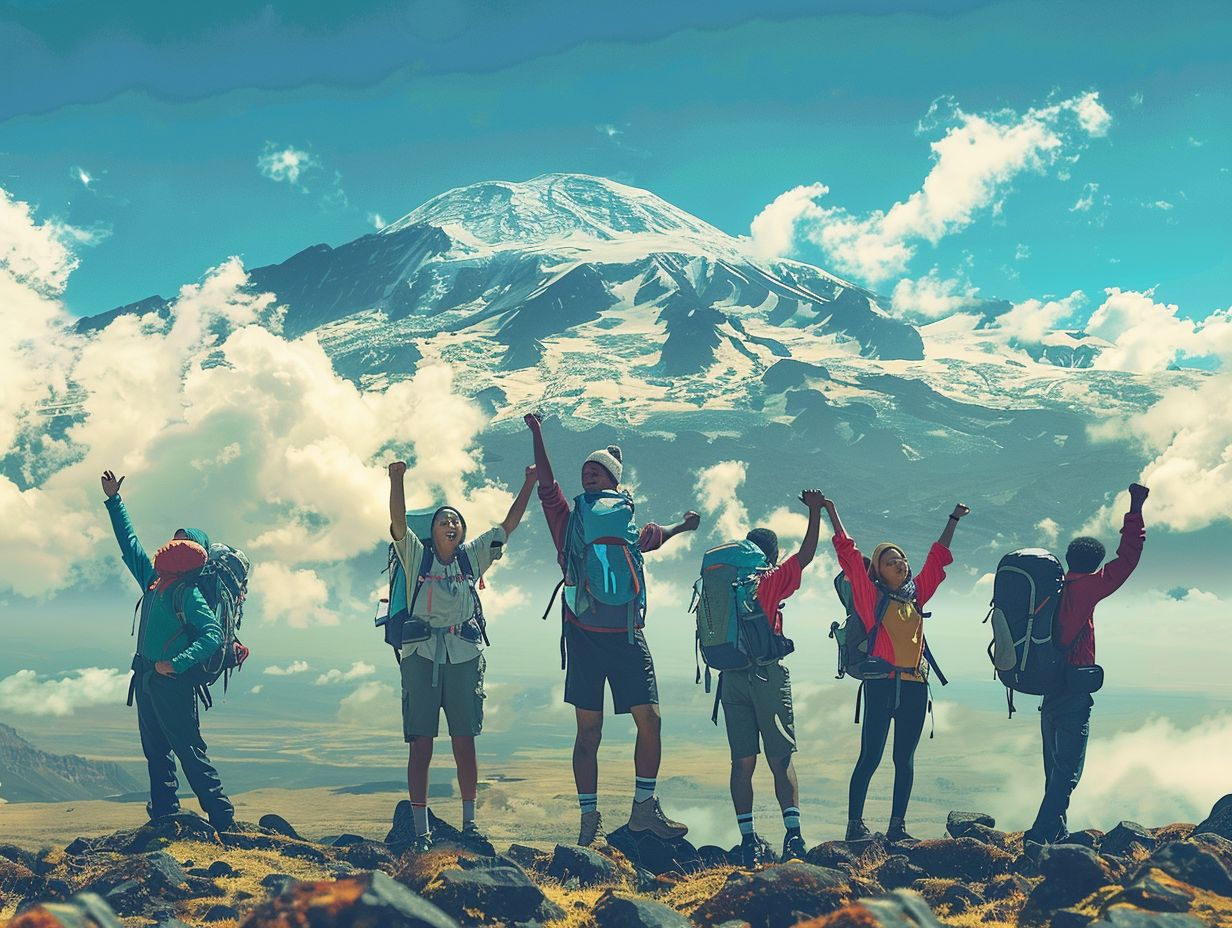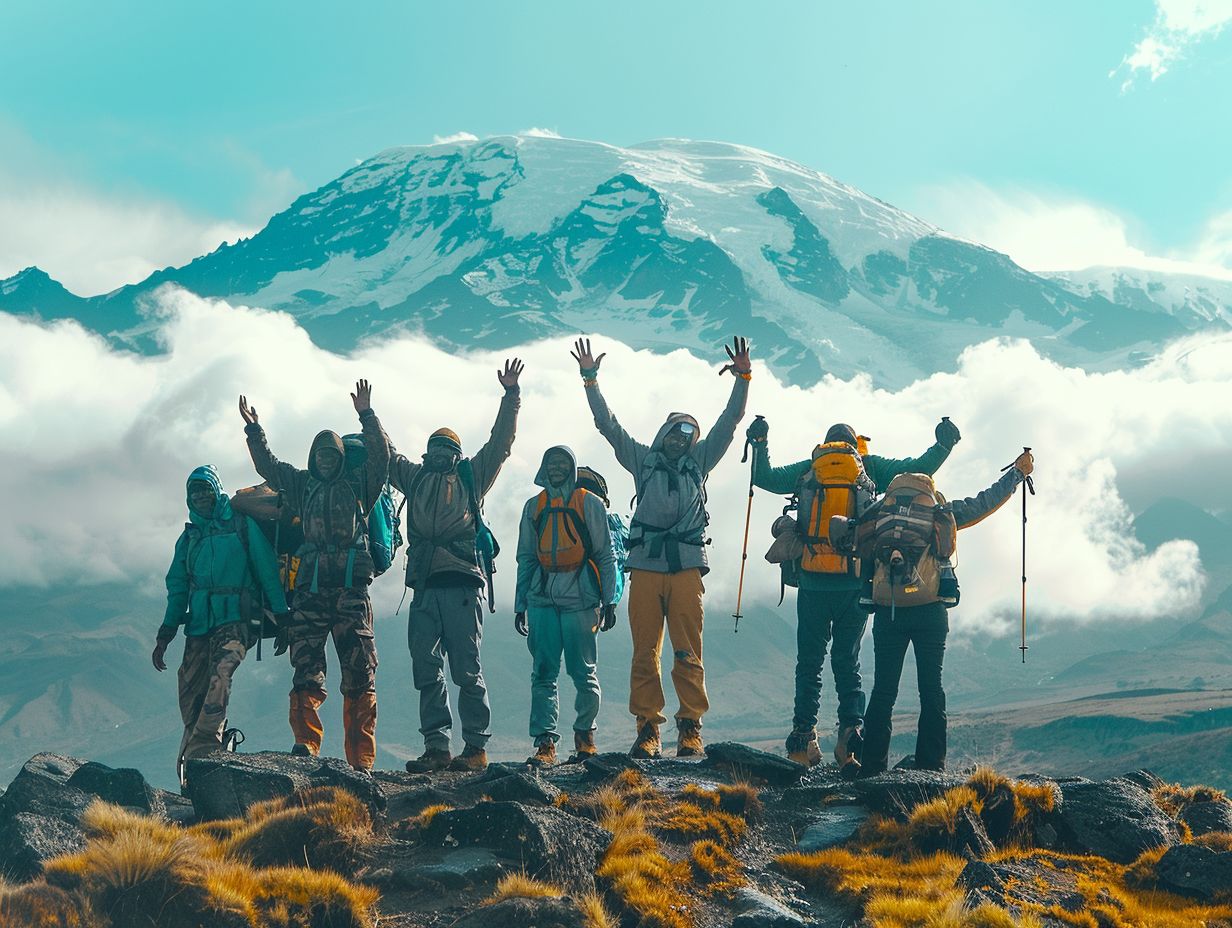
Dreaming of climbing the majestic Mount Kilimanjaro?
Before embarking on this epic adventure, it’s crucial to understand the physical and mental preparation required for such a feat.
We explore the physical requirements for climbing Kilimanjaro, the best exercises to prepare for the climb, and how long you should train before attempting it.
We also discuss the mental challenges of the ascent and provide tips on how to mentally prepare for the journey.
Learn about essential gear, clothing, food, and water you should pack for the climb, as well as what to expect during the climb, including how to prevent altitude sickness and navigate the weather and terrain.
If you’re ready to conquer Kilimanjaro, keep reading for valuable insights and tips for a successful climb.If you’re ready to conquer Kilimanjaro, keep reading for valuable insights and tips for a successful climb.
Key Takeaways:
- Proper physical training is crucial for successfully climbing Kilimanjaro. Focus on building endurance, strength, and balance through exercises like hiking, running, and weight training.
- The mental challenges of climbing Kilimanjaro can be just as demanding as the physical ones. Prepare yourself mentally by setting realistic expectations, staying positive, and practicing mindfulness.
- When packing for your Kilimanjaro climb, prioritize essential gear like proper footwear, warm clothing, and enough food and water. Research the weather and terrain beforehand to ensure you have the right equipment.
Physical Preparation for Climbing Kilimanjaro

Embarking on a Kilimanjaro climb requires both physical and mental preparation to tackle the challenges that come with scaling Africa’s tallest peak.
One of the key physical aspects of preparing for a Kilimanjaro climb involves incorporating a varied fitness routine that focuses on building strength, endurance and flexibility.
This can include activities like cardiovascular exercises, hiking, strength training and yoga to ensure your body is well-prepared for the demanding trek ahead. Investing in high-quality gear such as proper hiking boots, layered clothing, a reliable backpack, and essential accessories is crucial for a successful climb.
Mental preparedness is equally vital. To maintain focus and determination during the climb, practicing mindfulness techniques, visualization exercises and mental toughness training can be beneficial.
Building endurance through consistent training and gradually increasing the difficulty of your hikes is essential for acclimatizing to the altitude and overcoming fatigue during the ascent.
What Are the Physical Requirements for Climbing Kilimanjaro?
Before attempting the Kilimanjaro climb, it is crucial to understand the physical demands involved and the fitness level required to navigate the challenging terrain and high altitude successfully.
Training regimens play a vital role in preparing your body for the rigors of the Kilimanjaro climb. Focus on building cardiovascular endurance through activities like running, hiking, and cycling. Incorporate strength training exercises to develop the necessary muscle strength, particularly in the legs and core.
Regarding muscle conditioning, target exercises that enhance your leg muscles’ endurance and stability. Squats, lunges, calf raises, and planks are beneficial for strengthening the muscles needed to tackle steep inclines and rocky paths on the mountain.
At high altitudes, the body faces decreased oxygen levels, making it essential to acclimatize properly. Slowly ascending to allow your body to adjust, staying hydrated, and recognizing the symptoms of altitude sickness are crucial for a successful summit attempt on Kilimanjaro.
What Are the Best Exercises for Preparing to Climb Kilimanjaro?
To enhance your readiness for the Kilimanjaro ascent, incorporating a mix of cardio, strength training, and altitude simulation exercises into your fitness routine can significantly boost your climbing capabilities.
Cardio workouts like running, cycling, or stair climbing improve your cardiovascular endurance essential for the demanding trek. Meanwhile, incorporating strength-building exercises such as squats, lunges, and core workouts enhances your overall muscle strength, aiding in carrying backpacks and navigating steep terrains.
For altitude adaptation, consider incorporating high-altitude training techniques like sleeping in an altitude tent or spending time in simulated high-altitude environments to acclimatize your body to lower oxygen levels, mimicking the conditions at the Kilimanjaro summit.
How Long Should I Train Before Attempting to Climb Kilimanjaro?
The duration of your training regimen for the Kilimanjaro climb should ideally span several months to ensure your body’s readiness for the physical demands and altitude challenges encountered during the expedition.
By allowing for a sufficient timeline, you give yourself the opportunity to gradually build up endurance, strength and mental preparedness required for such a rigorous trek.
Consistent workouts form the backbone of your training plan, involving a mix of cardiovascular exercises, hiking, and strength training to target different aspects of fitness essential for conquering Kilimanjaro.
- Your regimen should be tailored to your current fitness level and progressively intensified to mimic the conditions you’ll face at higher altitudes. This approach not only reduces the risk of injuries but also enhances your performance come summit day.
- Consider incorporating altitude training, whether through simulated environments or actual high-altitude hikes, to accustom your body to lower oxygen levels and mitigate the effects of altitude sickness during the climb.
Mental Preparation for Climbing Kilimanjaro

Plus physical readiness, mental preparedness is key to overcoming the psychological challenges that arise during a Kilimanjaro climb, ensuring a successful and fulfilling experience.
When embarking on the journey to conquer Mount Kilimanjaro, one must be equipped not only with physical strength but also with mental resilience.
The mental aspect of the climb can often be underestimated, yet it plays a crucial role in determining success. Many climbers face self-doubt, fear, and anxiety as they tackle the grueling terrain and high altitudes.
- Managing stress is essential in such situations. Strategies like mindfulness, deep breathing exercises and positive visualization can help climbers stay focused and calm amidst the challenges.
- Cultivating a positive mindset is equally important. It allows climbers to maintain motivation and determination when faced with obstacles.
What Are the Mental Challenges of Climbing Kilimanjaro?
The mental obstacles encountered while climbing Kilimanjaro range from altitude-induced anxiety to isolation concerns, highlighting the importance of mental fortitude and resilience throughout the journey.
At high altitudes, climbers often experience physical and mental stress due to reduced oxygen levels which can trigger feelings of panic or unease. Mindfulness techniques such as deep breathing exercises and focusing on the present moment can help alleviate these symptoms.
Establishing a support network within the climbing group fosters camaraderie and combats feelings of isolation. Pre-expedition mental preparation, including visualizing successful outcomes and setting realistic goals, plays a critical role in maintaining a positive mindset when faced with daunting challenges on the ascent.
How Can I Mentally Prepare for Climbing Kilimanjaro?
Effective mental preparation for a Kilimanjaro climb involves visualization techniques, mindfulness practices, and setting realistic goals to foster a resilient mindset capable of overcoming the mental hurdles encountered during the ascent.
Visualization techniques are powerful tools that allow climbers to mentally rehearse each step of the climb, envisioning themselves successfully conquering various challenges along the way. By vividly picturing themselves overcoming obstacles, climbers can instill confidence and reduce anxiety before facing them in reality.
Mindfulness practices, such as deep breathing exercises and focusing on the present moment, help climbers stay grounded and calm amidst the physical and mental demands of the climb. They enable individuals to cultivate awareness of their thoughts and emotions, leading to enhanced concentration and emotional regulation.
Setting realistic goals is crucial in building a positive mindset for a Kilimanjaro expedition. Break down the climb into manageable milestones, celebrating each achievement along the way. By setting achievable objectives, climbers can maintain motivation and track their progress, boosting their overall confidence and mental preparedness.
What to Pack for Climbing Kilimanjaro
Careful consideration of the essential gear, clothing, food, and hydration supplies is paramount when assembling your packing list for a Kilimanjaro climb to ensure comfort, safety, and preparedness for varying conditions.
Among the crucial gear items, a sturdy pair of hiking boots with ankle support is essential to tackle the challenging terrain. It is advisable to pack a quality sleeping bag rated for low temperatures, a headlamp with extra batteries for early morning starts, and trekking poles for stability and balance on steep sections.
Regarding clothing essentials, packing moisture-wicking base layers to regulate your body temperature is essential. Bring along insulating layers, a waterproof jacket, and hiking pants to stay comfortable and protected from the elements.
As for nutritional provisions, high-energy snacks such as nuts, dried fruits, and energy bars are ideal for sustaining your energy levels during the climb. Packing a reusable water bottle or hydration bladder to stay hydrated at altitude is crucial for your well-being.
Essential Gear for Climbing Kilimanjaro
Key equipment such as sturdy hiking boots, a reliable backpack, and a quality sleeping bag are essential for a Kilimanjaro climb, ensuring comfort, safety, and functionality throughout the journey.
Having proper clothing layers for varying temperatures is crucial to combat the ever-changing weather conditions on the mountain. A waterproof jacket and pants will shield you from unexpected rain or snow, while moisture-wicking base layers help regulate body temperature and keep you dry.
Investing in high-quality merino wool or synthetic socks will prevent blisters and provide insulation. For head protection, a warm hat with ear coverage and sunglasses with UV protection are essential.
Carrying hydration systems such as a hydration bladder or water bottles is crucial to stay hydrated. Opt for a lightweight, insulated water bottle to prevent liquids from freezing at higher altitudes.
Regarding climbing poles, prioritize durable, adjustable trekking poles that provide stability on uneven terrain. Choosing reputable brands like North Face, Osprey, and Patagonia ensures the durability and reliability of your gear during the challenging trek up Kilimanjaro.
Clothing and Footwear for Climbing Kilimanjaro

Choosing appropriate layers, moisture-wicking clothing and waterproof outerwear is crucial for maintaining comfort and protection against the ever-changing weather conditions during a Kilimanjaro climb.
Layering is not just about keeping warm but also about managing moisture and adapting to temperature fluctuations. The base layer should be moisture-wicking to draw sweat away from the skin, preventing clamminess and potential chafing.
- Merino wool or synthetic materials such as polyester are popular choices for base layers due to their moisture-wicking properties.
- For the mid-layer, consider fleece or down jackets to provide insulating warmth.
Selecting weather-resistant outerwear, like a Gore-Tex jacket or pants, can shield you from wind and rain while allowing breathability to prevent overheating. Packing versatile clothing options ensures you stay comfortable throughout your climb.
Food and Water for Climbing Kilimanjaro
Proper hydration, high-energy snacks, and hearty meals are essential components of your nutrition plan for a Kilimanjaro expedition, providing the fuel and sustenance needed to conquer the challenging terrain and altitude effects.
When preparing for your Kilimanjaro climb, it’s crucial to focus on foods rich in carbohydrates, proteins, and healthy fats. Opt for complex carbs like oats, quinoa and whole grains to sustain energy levels.
Include lean proteins such as poultry, fish, and legumes to aid in muscle recovery. Healthy fats from avocados, nuts and seeds help support heart health and provide lasting energy.
Remember to stay hydrated by drinking plenty of water throughout the day. Consider adding electrolyte tablets or sports drinks to maintain a proper balance of fluids and minerals, especially at higher altitudes where dehydration is a common risk.
What to Expect During the Climb
Anticipating the challenges of altitude sickness, weather fluctuations, and demanding terrain is crucial for mentally preparing yourself to navigate the unique experiences encountered during a Kilimanjaro climb.
Altitude sickness remains one of the primary concerns for climbers ascending Kilimanjaro due to the rapid elevation gain. It is essential to acclimatize gradually by following the climb schedule meticulously and staying properly hydrated.
Recognizing symptoms early on, such as headaches or nausea and communicating openly with your guide is key to managing altitude-related issues.
Being equipped with proper gears to handle extreme weather changes on the mountain is imperative for a safe journey. Packing layers to adapt to chilly nights and scorching days is a wise strategy.
Altitude Sickness and How to Prevent It
Understanding the symptoms, effects, and preventive measures for altitude sickness is crucial for climbers aiming to mitigate the risks associated with high elevations during a Kilimanjaro trek.
Altitude sickness, also known as acute mountain sickness (AMS), generally occurs when ascending to high altitudes too quickly, wherein the body does not have enough time to acclimatize to the reduced oxygen levels.
The primary cause of altitude sickness is the decrease in air pressure and oxygen as altitude increases. Symptoms of this condition can range from mild headaches, dizziness, and fatigue to more severe forms like vomiting, blurred vision, and difficulty breathing.
Proper acclimatization is the key to preventing altitude sickness. Climbers are advised to ascend gradually, allowing their bodies time to adjust to the changing conditions. Staying hydrated, consuming a high-carbohydrate diet, and avoiding alcohol and tobacco can also help reduce the risk of altitude sickness during a Kilimanjaro expedition.
Weather and Terrain on Kilimanjaro
The ever-changing weather conditions, diverse terrains, and extreme temperatures on Kilimanjaro necessitate proper gear and preparation to adapt to the challenging elements encountered during the climb.
One of the key factors that climbers need to consider is the unpredictable climatic variations on Kilimanjaro. From scorching heat in the lower regions to freezing cold near the summit, the journey presents a wide range of weather challenges.
The mountain’s unique terrains, including lush rainforests, alpine meadows, rocky paths, and snowy peaks, demand specialized equipment and clothing to navigate safely and comfortably. It is essential to invest in weatherproof clothing that can withstand the harsh conditions, such as insulated jackets, waterproof pants, and sturdy boots.
Tips for a Successful Climb

Incorporating proper acclimatization, pace management, and hydration strategies can significantly enhance your chances of achieving a successful Kilimanjaro summit, ensuring a memorable and safe climbing experience.
Proper acclimatization involves gradually ascending to higher altitudes, allowing your body to adapt to the decreasing oxygen levels. It is essential to maintain a steady pace, avoiding overexertion, which could lead to altitude sickness.
Hydration plays a crucial role in preventing dehydration and supporting overall performance. Carrying a hydration pack and drinking regularly, even when not feeling thirsty, helps combat the effects of high altitude.
Employing these strategies in tandem can make your Kilimanjaro climb more enjoyable and ultimately increase your chances of reaching the summit.
Frequently Asked Questions
What is the recommended fitness level to climb Kilimanjaro?
The recommended fitness level to climb Kilimanjaro is moderate to high. It is important to have a good level of cardiovascular endurance, strength, and stamina to successfully complete the climb.
How can I improve my fitness for climbing Kilimanjaro?
Regular aerobic exercises such as hiking, cycling, running, and swimming can help improve your overall fitness level for climbing Kilimanjaro. Additionally, incorporating strength training exercises can also help build your muscles and increase your endurance.
Is it possible to climb Kilimanjaro if I am not very fit?
While it is possible to climb Kilimanjaro with a lower level of fitness, it is not recommended. The climb is physically demanding and being in good shape can greatly increase your chances of successfully reaching the summit.
Are there any age restrictions for climbing Kilimanjaro?
There are no official age restrictions for climbing Kilimanjaro, but it is important to assess your physical ability and consult with a doctor before attempting the climb. It is also recommended to be at least 18 years old to climb without a parent or guardian.
What are some signs that I may not be fit enough to climb Kilimanjaro?
If you experience shortness of breath, dizziness, or fatigue during moderate exercises, it may be a sign that you are not fit enough to climb Kilimanjaro. It is important to listen to your body and consult with a doctor if you have any concerns about your physical ability.
Is it necessary to train specifically for altitude while preparing to climb Kilimanjaro?
Yes, it is important to incorporate altitude training into your fitness routine while preparing for Kilimanjaro. This can include exercises such as hiking at high elevations or using an altitude training mask to simulate high altitude conditions.